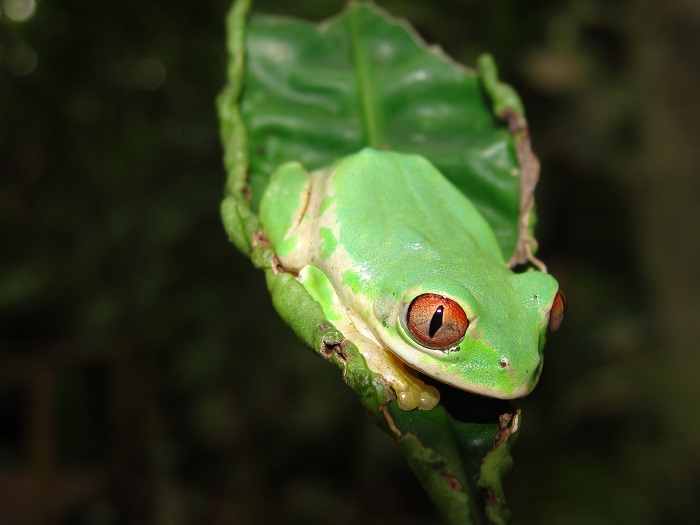Cover photo by A. Coetzer.
Find the Forest Tree Frog in the FBIS database (Freshwater Biodiversity Information System) here.
Family Heleophrynidae
Identification

Near Kosi Bay, KwaZulu-Natal
Photo by Ryan Tippett
Adult:
Size: Attains 65mm.
Leptopelis natalensis has large, bulging, orange-red eyes with vertical pupils and a blunt, rounded snout. The tympanum (ear drum) is conspicuous.
The colouration and patterning varies. They are often plain lime green above but may also be pale brownish with emerald green bands and blotches. The emerald green markings have fine black outlines. Plain, pale brown specimens can also be found. The underparts are off-white, while the underside of the legs are yellowish.
The skin is slightly rough above and more granular below.
They have elongate arms and legs. The hands and feet are well developed. Fingers and toes are long and equiped with large terminal discs to enhance their climbing ability. The fingers on the forelimbs are unwebbed while the toes on the hindlimbs have ample webbing.
There is no clear sexual dimorphism but males are slightly smaller than females.
Tadpole:
Size: Up to 50mm.
Tadpoles of Leptopelis natalensis are elongate and slender with a somewhat flattened appearance. The overall colouration is brown with variable beige mottling. The tail is roughly twice as long as the body and the upper and lower fins are almost of equal length.
Habitat
The breeding and non-breeding habitats of the Forest Tree Frog are Coastal Forest, Sand Forest, and Coastal Bushveld/Grassland. It is found in the Forest and Savanna biomes. L. natalensis is usually found near swamps or pans in fairly dense, indigenous forest, although it occasionally occurs in habitats similar to those inhabited by Hyperolius pickersgilli, such as stagnant water marshes.

Photo by Ryan Tippett
Behaviour
Most breeding activity takes place in summer once the rainy season is well underway. Males usually begin calling at dusk from exposed positions up to 3 m above the ground in the foliage of trees and bushes close to, or overhanging, water. The females are usually much larger than males. Amplexus is axillary. Amplexing pairs move down to the ground where the female excavates a shallow burrow near the water’s edge in which c.200 light-yellow eggs are laid. The female fills the burrow, disguising its location with leaves and twigs (pers. obs). About 13 days later, the tadpoles leave the egg capsules and move towards the water with jumping and wriggling movements (Wager 1965). The remainder of larval development takes place in the usual way.
Predators are thought to include birds, snakes and terrapins, while prey usually consists of large flying insects such as noctuid moths.

Pietermaritzburg, KwaZulu-Natal
Photo by Geoff Prosser
Advertisement Call
The Natal Tree Frog has a loud and unmistakable call that consists of buzzing and quacking noises. Vocalising males are hard to locate.
Status and Conservation
The major threat to the Forest Tree Frog is habitat loss resulting from water drainage, invasions of alien plants, and afforestation. In several areas in KwaZulu-Natal, Eucalyptus plantations have lowered the water table to such a degree that many pans adjacent to coastal dune forest have completely disappeared.
L. natalensis occurs in several protected areas, for example, Krantzkloof Nature Reserve, Mkuze Game Reserve, Greater St Lucia Wetland Park, and Twinstreams-Mtunzini Natural Heritage Site. It is fairly common within its range, but local populations are probably quite small. The species does not appear to require any special conservation action at present.
Distribution

Leptopelis natalensis is endemic to KwaZulu-Natal and the northeastern part of Eastern Cape Province of South Africa. It occurs along the northeastern coast from Sodwana Bay (2732DA) in the north to Manubi (3228BB) in the south. The atlas data is accurate and reasonably complete.
Further Resources
The use of photographs by A. Coetzer and Geoff Prosser is acknowledged. Other photographs by Ryan Tippett.
Forest Tree Frog Leptopelis natalensis (Smith, 1894)
Other Common Names: Natal Tree Frog (Alternative Common Name); Natalse Boompadda (Afrikaans)
Recommended citation format: Bishop, PJ; Tippett, RM. (2025). Forest Tree Frog Leptopelis natalensis. Biodiversity and Development Institute, Cape Town. Available online at https://thebdi.org/2021/09/27/forest-tree-frog-leptopelis-natalensis/
This species text has been updated and expanded from the text in the
2004 frog atlas: Bishop, PJ. (2004). Forest Tree Frog Leptopelis natalensis. In Minter LR
et al 2004.
References:
Minter, LR; Burger, M; Harrison, JA; Braack, HH; Bishop, PJ; Kloepfer, D. (Editors). (2004). Atlas and Red Data Book of the Frogs of South Africa, Lesotho and Swaziland. Smithsonian Institution, Washington, and Avian Demography
Unit, Cape Town.
Carruthers, V; du Preez, L. (2017). Frogs of southern Africa: A Complete Guide. Struik Nature, Cape Town.
Channing, A. (2001) Amphibians of Central and Southern Africa. Protea Book House, Pretoria
Claus, B; Claus, R. (2002). Common Amphibians and Reptiles of Botswana. Gamsberg Macmillan, Windhoek.

